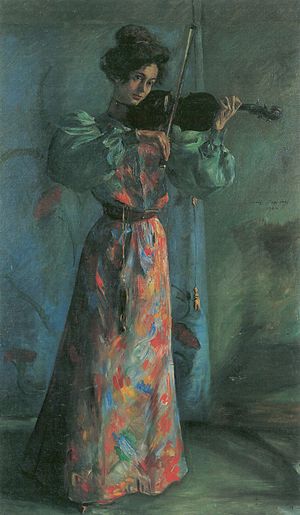The violin player

|
| The violin player |
|---|
| Lovis Corinth , 1900 |
| Oil on canvas |
| 200 × 120 cm |
| Chemnitz art collections , private loan |
The violin player is a life-size painting by the German painter Lovis Corinth . The portrait shows Margarete Matschalk , who later became Gerhart Hauptmann's wife , and was painted in 1900. Today it is on permanent loan in the Chemnitz art collections.
Image description
The picture shows a full-length young woman who is standing playing a violin . The background is a blue-green curtain with a flower pattern and a golden cord; the wall behind it and the floor are dark green. According to Zieglgänzberger 2008, the drawn curtain "with curved and Japanese-style floral decoration" and the "unclear room situation" indicate an "intimate evening or night performance by the violinist". The woman wears a colorful dress (described in the catalog raisonné as a “colorful dress”) with very roughly depicted red, blue, green and orange colored areas, wide green puffed sleeves and a high collar; it is held together by a belt at the waist. The hair is pinned up into a hairstyle. Due to the overall representation of the portrait, the musician appears “almost weightless” in the picture, enhanced by the “balloon-like puffed sleeves”.
The woman is painted slightly rotated and shows the viewer the right side of her body; she does not look directly at the viewer, but appears absorbed in the music game. Only a single toe can be seen under the dress. With her right hand she holds the violin bow , which rests on the strings, the left hand is on the fingerboard .
On the right edge of the picture in the middle, under the left sleeve, is the painting with the words
- Lovis Corinth 1900
signed.
background
The woman portrayed was Gerhart Hauptmann's partner Margerete Marschalk at the time, who had lived with him since around 1894 and married him in 1904. The portrait was created after a work for Hauptmann, who had commissioned Corinth with a portrait of him ( portrait Gerhart Hauptmann , BC 202). Corinth had met Margerete Marschalk, then 25, here and at meetings of the "Gerhart Hauptmanns Friendship and Rose Association" founded by Walter Leistikow .
Corinth decided to make a portrait of her after completing the commissioned portrait. On October 23, 1900 he wrote a letter to the doctor and collector A. Ulrich in Leipzig:
“I have now painted Gerhart Hauptmann and will probably paint something feminine now, but you just do it like that. Orders in gold and silver are not yet available. "
The letter shows that he made the life-size portrait of the woman out of his own initiative and interest, and not as a commissioned work. The picture was taken in Hauptmann's apartment in Berlin-Grunewald . On November 5, Corinth wrote another letter to A. Ulrich to arrange an appointment:
“In the afternoons I work the whole week in Grunewald, portrait v. GH woman. "
Provenance
The violin player was first bought by Henry B. Simms for his collection, but later became the property of Hauptmann and hung in the tea room of his house "Wiesenstein" in Agnetendorf . His son Benvenuto Hauptmann (1903–1965) took over the picture and later it came to a private collection in Bochum.
supporting documents
- ↑ a b c d Roman Zieglgänzberger: The violin player. In: Ulrike Lorenz , Marie-Amélie zu Salm-Salm, Hans-Werner Schmiedt (eds.): Lovis Corinth and the birth of modernity . Kerber Verlag Bielefeld 2008; Pp. 210-211. ISBN 978-3-86678-177-1 .
- ↑ a b c d e Charlotte Berend-Corinth : Lovis Corinth. Catalog raisonné. Revised by Béatrice Hernad. Bruckmann Verlag, Munich 1958, 1992; BC 196, p. 83. ISBN 3-7654-2566-4 .
- ^ A b Thomas Corinth: Lovis Corinth. A documentation. Compiled and explained by Thomas Corinth. Verlag Ernst Wasmuth, 1979. p. 63. ISBN 3-8030-3025-0 .
- ^ A b Peter-Klaus Schuster , Christoph Vitali, Barbara Butts (eds.): Lovis Corinth . Prestel Munich 1996; P. 140. ISBN 3-7913-1645-1 .
literature
- Peter-Klaus Schuster , Christoph Vitali, Barbara Butts (Eds.): Lovis Corinth . Prestel Munich 1996. ISBN 3-7913-1645-1
- Charlotte Berend-Corinth : Lovis Corinth: The paintings . Revised by Béatrice Hernad. Bruckmann Verlag, Munich 1992; BC 586, p. 143. ISBN 3-7654-2566-4 .
